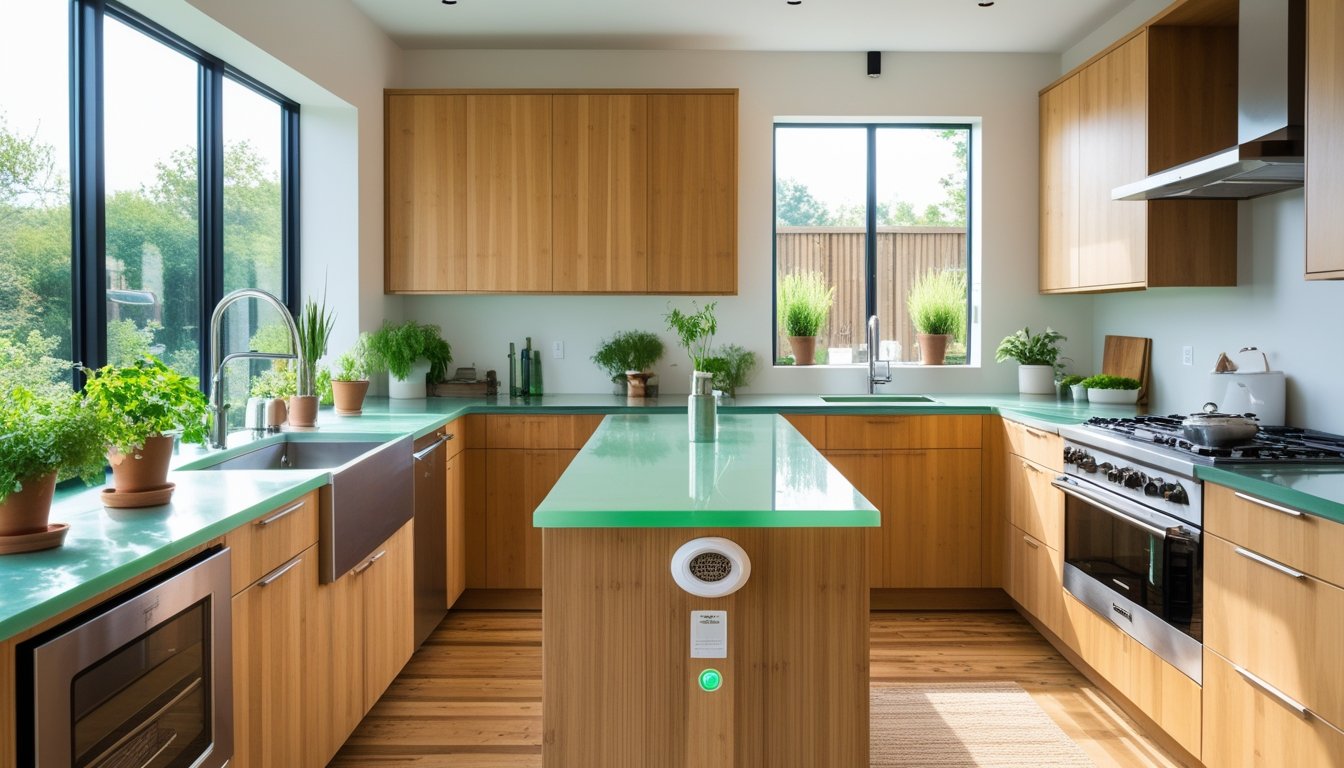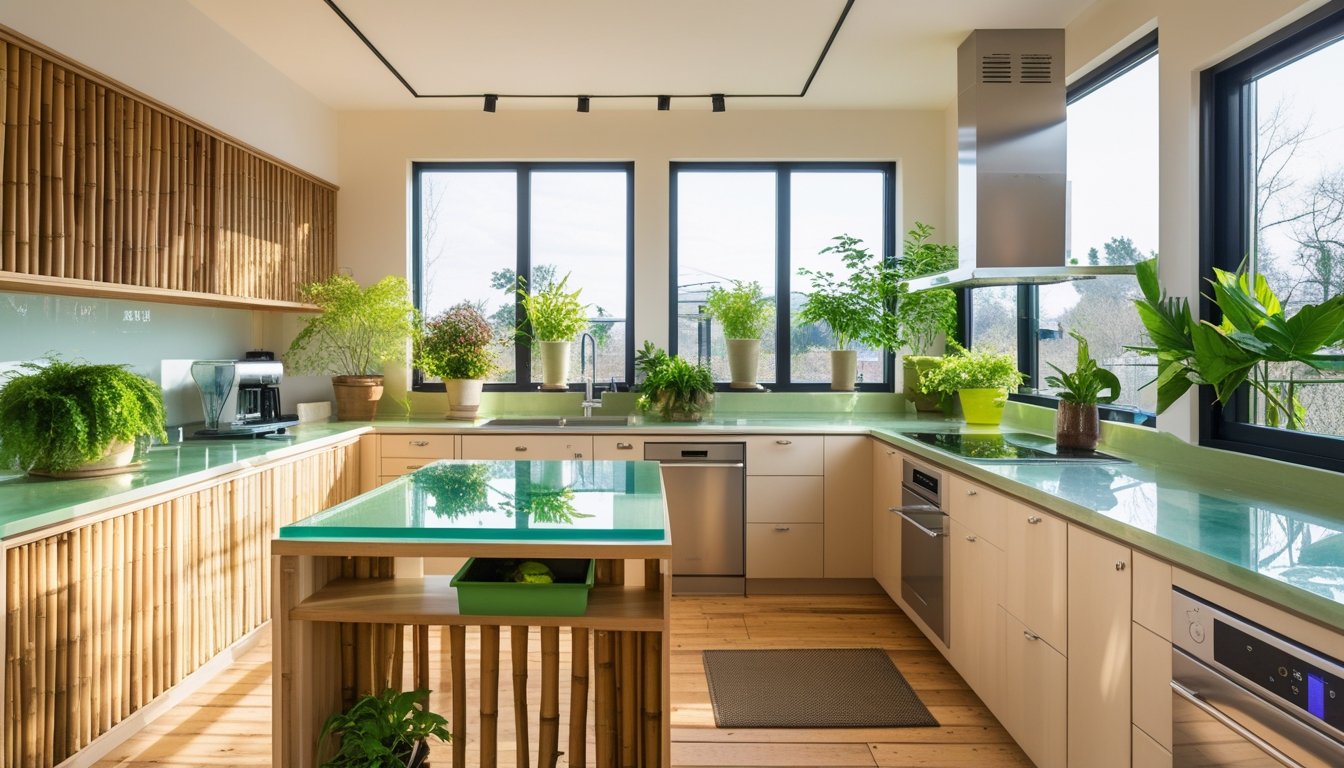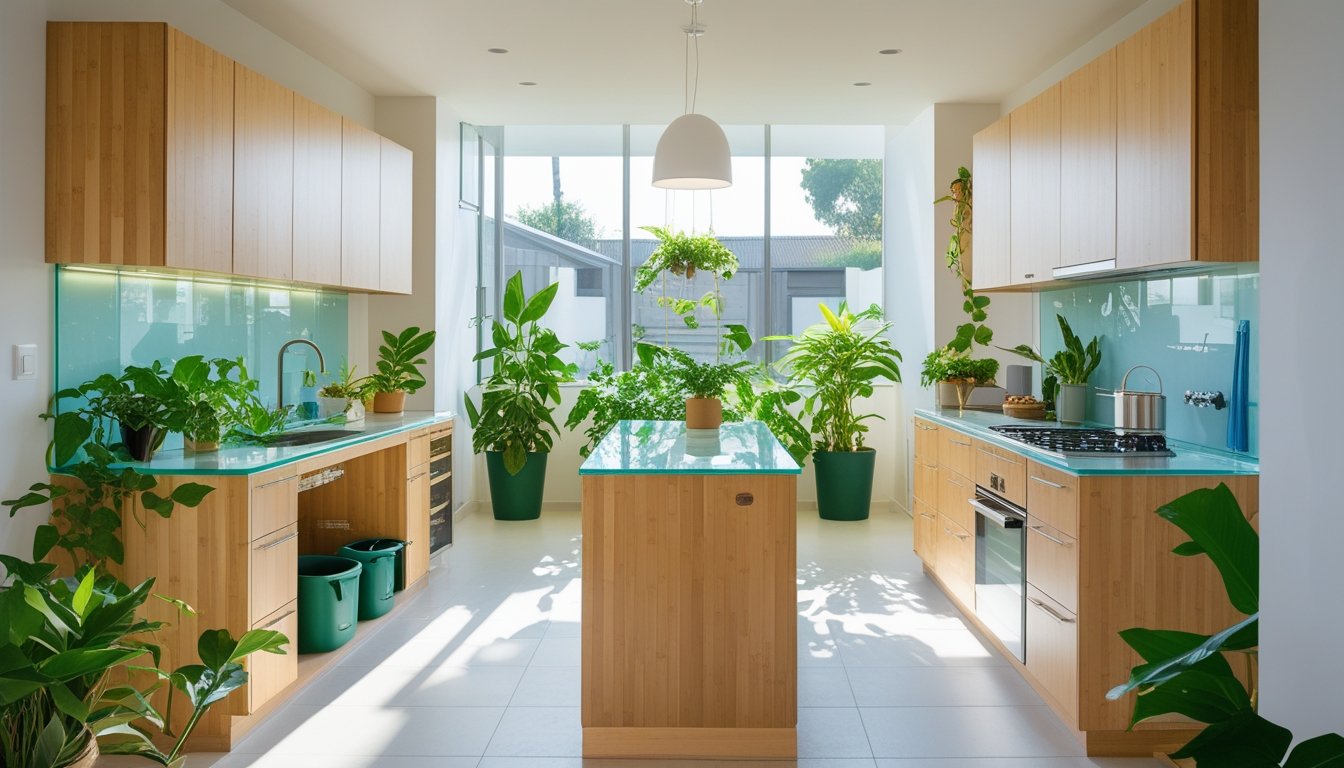Late updated: 10 Jul 2025 09:07
Written by: Daniel Harper
Innovative Eco-Friendly Kitchen Design Ideas: Transform Your Cooking Space
In today's world, where sustainability is becoming a key priority, reimagining our kitchens with eco-friendly designs is a compelling prospect for us all. A kitchen that embraces sustainability not only benefits the environment but also enhances the aesthetic and functionality of our homes. Incorporating features like energy-efficient appliances, recycled materials, and innovative design principles can transform any cooking space into a green sanctuary.

We understand that innovation in eco-friendly kitchen design is about blending style with sustainability. By using reclaimed wood and recycled materials, we can create stunning countertops and cabinets that exude charm while reducing waste. Vertical garden walls are another ingenious addition that bring freshness and a natural touch to our kitchens, allowing us to cultivate herbs right where we need them.
For those of us looking to undertake kitchen renovations, knowing which designs and materials to choose can significantly impact both environmental conservation and our daily living experiences. Energy-efficient lighting, sustainable flooring, and smart water-saving fixtures are all part of crafting a living space that prioritises planetary health without compromising on style.
Key Takeaways
- Innovative designs merge style with sustainability.
- Eco-friendly kitchens utilise energy-efficient and recycled materials.
- Green spaces enhance functionality and reduce environmental impact.
Core Principles of Innovative Eco-Friendly Kitchen Design

Innovative eco-friendly kitchen design hinges on several core principles: using sustainable and recycled materials, incorporating energy-efficient appliances, improving water conservation and air quality, and implementing smart waste management solutions. These elements collectively create a kitchen that is both environmentally responsible and stylish.
Utilising Sustainable and Recycled Materials
In eco-friendly kitchen design, the choice of materials is crucial. Sustainable options like reclaimed wood and bamboo provide durability and a natural aesthetic. Recycled materials are also a key component. For countertops and tiles, recycling glass is a popular choice. Recycled glass countertops not only look stunning but also reduce landfill waste. When attempting to reduce a kitchen's carbon footprint, using such materials is essential. We have to prioritise materials that are free from harmful chemicals, like low-VOC paint, ensuring both safety and sustainability.
Integrating Energy-Efficient Appliances and Lighting
To enhance energy efficiency, the kitchen should feature appliances like energy-efficient refrigerators and induction cooktops. These appliances reduce energy consumption and help lower utility bills. Lighting is another area ripe for improvement. The use of LED lighting is essential. LEDs are long-lasting and consume less energy compared to traditional bulbs. Moreover, integrating smart appliances can bring further energy savings. This advanced technology allows us to monitor and control energy usage remotely, making energy management more accessible and efficient.
Improving Water Conservation and Indoor Air Quality
Water conservation in the kitchen can be achieved by installing low-flow faucets. These reduce water usage without compromising performance. Improving indoor air quality is equally important. Utilising non-toxic finishes and incorporating non-toxic cleaning products helps in maintaining a healthy environment. Additionally, proper ventilation is crucial. Implementing effective ventilation systems helps remove pollutants, ensuring that our indoor air quality remains high and our kitchen spaces are safe and comfortable.
Smart Waste Management and Composting Solutions
Effective waste management is a cornerstone of eco-friendly kitchen design. Adopting smart waste reduction strategies can significantly reduce the amount of waste sent to landfill. Composting systems present an ideal solution for organic waste. We can implement composting solutions that are user-friendly and efficient, transforming kitchen waste into nutrient-rich soil. Separation bins aid in categorising waste, making it easier to recycle and compost effectively. This approach not only reduces our environmental impact but also connects us closer to sustainable living practices.
Design Strategies for a Stylish and Sustainable Kitchen
Achieving both style and sustainability in kitchen design requires careful planning and selection of materials, appliances, and layout. Utilising natural light, innovative layouts, and eco-friendly cabinetry are some of the strategies we can explore.
Maximising Natural Light for Energy and Wellbeing
Natural light is a fundamental tool in creating a sustainable kitchen. Well-placed windows and skylights can reduce the need for electricity during the day, cutting energy use. Large, south-facing windows can also create a warm and welcoming atmosphere, enhancing our wellbeing.
Reflective surfaces, such as glass tiles and stainless steel appliances, help to distribute light throughout the space. Solar tubes are another innovative solution for bringing natural light into areas that lack direct access to windows. Maximising natural light not only conserves energy but also boosts the mood of everyone in our home.
Innovative Kitchen Layouts for Efficiency
An efficient kitchen layout is essential for both functionality and sustainability. The ‘work triangle’—a classic design principle—places the sink, refrigerator, and cooker in a triangle for efficient movement. We can adapt this principle in various ways to suit our unique kitchen spaces.
Consider open-plan designs that integrate with living areas, offering both space and flexibility. Islands can serve dual purposes: food preparation and dining. Multi-level countertops and flexible workstations cater to diverse cooking tasks. These innovative designs reduce unnecessary movement and improve overall energy efficiency, aligning with the drive for sustainability.
Cabinetry and Surface Solutions with Low Environmental Impact
Selecting eco-friendly cabinetry and surfaces helps us minimise the environmental impact of our kitchen. Bamboo cabinets are a popular choice, being both durable and renewable. They add a touch of natural elegance while contributing to environmental conservation.
For worktops, recycled materials like glass or reclaimed wood offer sustainable alternatives. Low-VOC (volatile organic compounds) finishes on surfaces do not emit harmful chemicals, ensuring a healthier kitchen environment. By choosing such sustainable materials, we align style with eco-consciousness, making our kitchens both beautiful and planet-friendly.
Budget-Friendly Green Kitchen Upgrades
Upgrading a kitchen doesn't need to be expensive. Repainting cabinets with environmentally friendly paints can revitalise our kitchen's look. Replacing traditional bulbs with LED lights is an effective, economical change that enhances energy efficiency.
Thrift shops and salvage yards are treasure troves for unique fixtures, like vintage handles and hooks, adding character while reducing waste. Consider installing low-flow taps to conserve water. These simple, cost-effective upgrades allow us to embrace a greener lifestyle without breaking the bank, helping to bridge the gap between affordability and sustainability.
Frequently Asked Questions

Creating an eco-friendly kitchen involves thoughtful choices regarding materials, recycling practices, and energy-efficient alternatives. We aim to address common queries and provide insights for a sustainable kitchen transformation.
How can one incorporate sustainable materials into kitchen cabinetry?
Selecting eco-friendly materials such as bamboo or reclaimed wood can drastically reduce environmental impact. These options not only promote sustainability but also offer aesthetic appeal and durability. Additionally, sourcing cabinets with formaldehyde-free finishes ensures indoor air quality remains healthy.
What are the best practices for recycling materials in kitchen design?
We advocate for integrating recycling systems into kitchen layouts, including dedicated bins for separating waste. Repurposing salvaged wood and metals for countertops or backsplashes contributes to a lower carbon footprint. Using recycled glass or composite materials is another effective way to maintain sustainability.
Which companies lead the industry in sustainable kitchen manufacturing?
Several companies excel in creating sustainable kitchen solutions. Brands like IKEA and Boffi utilise eco-friendly materials and energy-efficient technologies in their products. Assessing certifications, such as FSC or Cradle to Cradle, helps identify firms committed to green practices.
What should be considered when planning an eco-friendly kitchen renovation?
When planning renovations, consider energy-efficient appliances, lighting, and insulation. Prioritising water-saving fixtures and composting systems contributes to long-term environmental benefits. Collaborating with contractors experienced in sustainable practices ensures a smoother transition and maximised eco-efficiency.
Where can one find used kitchen cabinets in good condition?
We recommend exploring salvage yards, online marketplaces, or second-hand stores for quality used cabinetry. These options offer cost-effective solutions while reducing waste. By purchasing pre-loved cabinets, one contributes to circular economy efforts, giving existing materials a new life.
What are eco-conscious alternatives to traditional kitchen fittings and appliances?
Look for products labelled with Energy Star ratings or comparable certifications. Opting for low-flow taps, induction cooktops, and LED lighting helps conserve resources. Moreover, choosing materials such as recycled glass or stainless steel for sinks and countertops further supports an eco-friendly kitchen environment.
